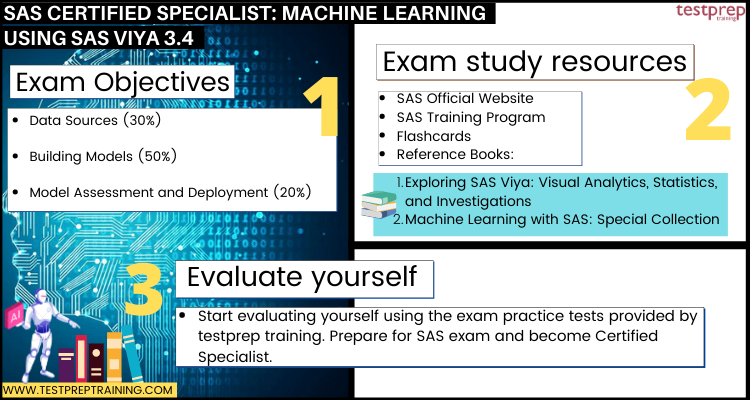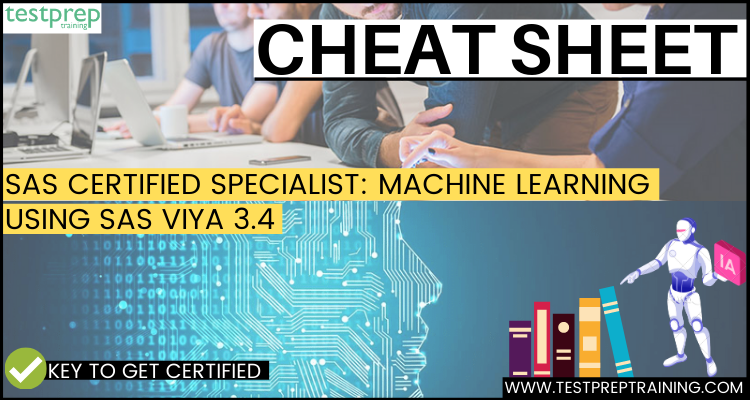The best way to start revising for the SAS exam is to create a map with all the details and resources then, start in a step-wise manner. Related to this, SAS Certified Specialist: Machine Learning Using SAS Viya 3.4 Cheat Sheet is designed to provide you a sequential way to have strong revision. We all know that this certification exam is are most suitable certification for getting core understanding and experience in AI. The SAS Machine Learning Using SAS Viya 3.4 exam demands proficiency in AI and Analytics Talent, utilizing both Open Source and SAS tools. By consolidating these aspects, this cheat sheet proves to be a valuable resource throughout your preparation.
So, first let’s start with basics of the exam and cover the overview part.
Machine Learning Using SAS Viya 3.4: Exam Overview
SAS Machine Learning Using SAS Viya 3.4 exam requires to showcase your AI and Analytics Talent using Open Source and SAS tools to garner insight from data. This exam tests your knowledge of Visual Data Mining and Machine Learning software and skills such as,
- Firstly, preparing data and feature engineering
- Secondly, creating supervised machine learning models
- Thirdly, assessing model performance
- Lastly, deploying models into production
Your must know that this exam is good if you want to become data scientists for creating supervised machine learning models using pipelines in SAS Viya.
Quick Cheat Sheet for SAS Certified Specialist: Machine Learning Using SAS Viya 3.4
The SAS Certified Specialist: Machine Learning Using SAS Viya 3.4 exam holds global recognition, significantly enhancing the value of your resume by validating your skills and knowledge. Achieving success in this exam requires substantial dedication, passion, effort, and time. However, with the right resources and training, you can effectively prepare and excel in the SAS exam. Without further delay, let’s explore the essential resources to facilitate a quick revision.

Understanding Exam Topics
The exam objectives for SAS Certified Specialist: Machine Learning Using SAS Viya 3.4 helps you get in-depth details about the methods, components, resources, and the exam description. Moreover, with having a thorough analysis of the exam concepts will let you align yourself more deeply with the major objectives of the exam. As a result, you will also be able to review and mark the sections and topics you find difficult for studying later. However, the topics that are included in this exam are provided below:
Data Sources (30%)
- Create a project in Model Studio (Reference: Creating a New Project)
- Explore the data (Reference: Easing into Data Exploration, Reporting, and Analytics Using SAS Enterprise Guide)
- Modify data (Reference: MODIFY Statement)
- Reduce the dimensionality of the data (Reference: Multivariate Analysis: Principal Component Analysis)
- Use the VARIABLE SELECTION node to identify important variables (Reference: Variable Selection Node)
Building Models (50%)
- Describe key supervised machine learning terms and concepts (Reference: Machine Learning)
- Build models with decision trees and ensemble of trees (Reference: Tree-Based Machine Learning Methods in SAS Viya)
- Building models with neural networks (Reference: How to build deep learning models with SAS)
- Build models with support vector machines (Reference: Application of Support Vector Machine Modeling and Graph Theory Metrics for Disease Classification)
- Use Model Interpretability tools to explain black box models (Reference: Explaining complex models in SAS Viya with programmatic interpretability)
- Incorporate externally written code (Reference: Registering an External File with User-Written Code)
Model Assessment and Deployment (20%)
- Explain the principles of Model Assessment (Reference: Model assessment and selection in machine learning)
- Assess and compare models in Model Studio (Reference: Compare Models)
- Deploy a model (Reference: How to deploy and run your model with SAS Model Manager to the SAS Micro Analytic Score Service)
SAS Official Website
Visiting the SAS official website is an important step while preparing for the Machine Learning exam. However, the official site offers a lot of reliable information and sources for good exam preparation. There you can find the resources such as study guide, documentation, sample papers, flashcards, whitepapers and FAQs. Moreover, this will help you in staying up to date with the latest exam modifications and changes.
SAS Training Program
Training programs by SAS are a very necessary step in the preparation of such exams like SAS Certified Specialist: Machine Learning Using SAS Viya 3.4. SAS offers its own training programs on their various examinations and certifications. These training courses provide a solid theoretical foundation for various techniques related to supervised machine learning models. Additionally, they incorporate a business case study designed to lead you through all stages of the analytical life cycle. This encompasses understanding the problem, data preparation, feature selection, model training and validation, as well as model assessment and deployment.
SAS Flashcards
Studying flashcards will test your knowledge about the SAS Viya 3.4 exam with quiz-style printable flashcards. And, the study flashcards highlight the most critical learning points from the SAS Viya 3.4 study guide.
Using Books for better understanding
Books are often the initial resource that springs to mind when gearing up for an exam. They are easily accessible, allowing us to select books based on our convenience. You can explore numerous titles available at online stores, bookstores, or libraries based on your comprehension level. For this exam, some recommended books are:
- Exploring SAS Viya: Visual Analytics, Statistics, and Investigations
- Machine Learning with SAS: Special Collection
Practice Test
Engaging in practice tests is crucial during exam preparation, offering insights into both your strengths and weaknesses. Effective time management is vital during the exam, and practicing helps enhance your answering skills, ultimately saving valuable time. It’s advisable to begin practice tests after completing a specific topic, serving as a valuable revision exercise.



